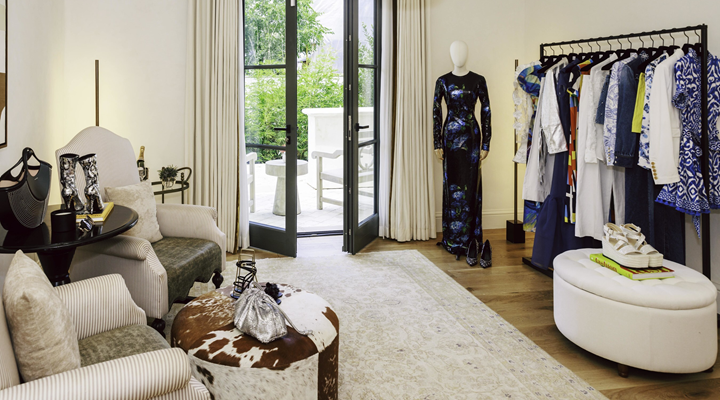While the everyday consumer has become price-sensitive with the growing costs of living in the US, the 1 per cent is still spending – to a point where the luxury shopping market has become more competitive than ever. According to global data and business intelligence platform Statista, the luxury goods market is projected to generate a revenue of US$368.9 billion in 2024. The market is expected to grow at a compound annual growth rate of 3.22 per cent between 2024 to 2028, with luxury fashio
hion making up the largest segment at an estimated market volume of US$115.9 billion in 2024.
As high-end retailers seek to capture and hold onto the 1 per cent shopper’s attention, Saks Fifth Avenue is ramping up its personalised shopping concept, Fifth Avenue Club.
What are the factors behind the Fifth Avenue Club’s rapid expansion?
For those unfamiliar with the concept, Fifth Avenue Club is a suite within high-end hotels and resorts where Saks provides consumers with a highly personalised styling and shopping experience.
Saks has opened four of these suites in Georgia, Colorado, Minnesota and, most recently, Austin, Texas.
As Larry Bruce, the president at Saks Fifth Avenue, stated in a public release, “Since the introduction of this concept last year, we are proud to have cultivated a new, engaged client base and a skilled stylist team that delivers one-of-a-kind personal shopping and styling tailored to the unique lifestyles of our customers within each community. We look forward to continued expansion of the highly personalised service and the expertly curated luxury assortment that Saks is known for to even more clients across the US.”
In the same release, the high-end department store announced plans to end the year with 20 new standalone shops across Texas, Florida, and California.
Marie Driscoll, a chartered financial analyst and a professor at Parsons, The New School and the Fashion Institute of Technology, linked Saks’ investment in personal shopping to the overall demand for physical retail experiences.
“Post the pandemic lockdown and avoidance of public places, consumers gradually became aware that they missed visiting physical stores and in-real-life shopping and all the positives the physical shopping experience potentially offers; sensual experiences of smell, sight and touch, social engagement, product and brand discovery, high touch services from one-to-one stylist advice and product selection, tailoring, and hospitality,” Driscoll told Inside Retail.
The retail expert noted that “for discretionary luxury shopping in physical retail, this is paramount”.
“Saks’ expansion of its Fifth Avenue Club addresses consumer desire for experiential retail, to be indulged and catered to in a hyper-personalised fashion and to discover fashion brands, products and outfits specifically curated for the individual shopper. These experiences create trust, reduce returns and enhance customer lifetime value,” she said.
Appealing to the time-strapped luxury consumer
Saks isn’t the only player in the luxury retail game offering a personal shopping experience for high-earning consumers.
Another strong competitor in this field is the German-based e-commerce retailer Mytheresa.
In a discussion with Mytheresa’s North American president Heather Kaminetsky, the retail executive said that exclusive fashion and accessory items, such as capsule collections with designer brands Gucci, Bottega Veneta, Loewe, and Brunello Cucinelli, aren’t the biggest drivers of Mytheresa’s rising status in the American retail market.
The key to catering to the 1 per cent consumer, Kaminetsky revealed, is offering them the one thing money can’t buy: time.
“I think the most important thing [to know] about our clientele is that the biggest luxury they crave is time. A lot of our consumers are extraordinarily busy, whether it’s with their family, business or travelling, time is never on their side,” Kaminetsky stated.
“That’s where we make shopping easy for them.”
By offering consumers a limited, but enticing array of products during an engaging experience with a personal shopper, Mytheresa effectively ticks an item off the time-strapped, high-earning shopper’s to-do list.
The key to Mytheresa’s success is its curation: rather than offering 100 different white-button shirts from luxury apparel brands, it selects the best-of-the-best that the retail industry has to offer.
It does this by strictly limiting the brands on its website to 250. If a brand is not performing to the best of its ability, then it will be replaced by a brand that consumers are more likely to engage with and be enticed to shop from.
New competitors tapping into the personal shopping craze
A newer player making strides in this highly competitive field is In-Seam, an e-commerce site launched in 2020 by former wholesale buyer and sales director Ann Wehren.
The site gives its community of more than 200 personal shoppers immediate access to the full product assortments of over 100 popular luxury brands.
Where most personal shoppers have limited options to source from multi-brand retailers like Net-a-Porter, Moda Operandi, or even Mytheresa, In-Seam’s team of stylists can get their hands on a wider array of products for their clients.
Wehren reported that by catering to its team of highly experienced personal shoppers versus appealing directly to retailers, In-Seam provides an even more tailored shopping experience for wealthy consumers and can sell 10 times more products per brand than the average luxury multi-brand retailer.
The company most recently reported that it is on track to drive US$300 million in annual gross merchandise value by 2027.

